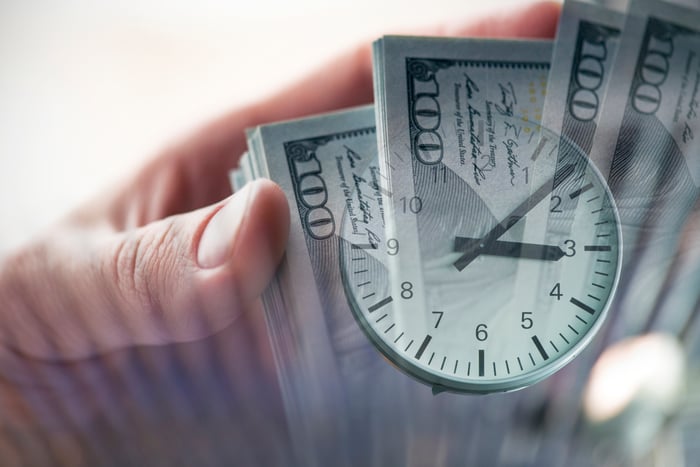Although stock market volatility never truly goes away, 2020 has been a year unlike anything Wall Street has ever seen before. The coronavirus disease 2019 (COVID-19) pandemic crammed a full decade's worth of volatility into a four-month window and took investors on the ride of their lives. While short-term traders are probably still pulling their hair out, long-term investors are likely doing just fine.
Historically speaking, while stock market corrections and bear markets are inevitable, long-term investors in high-growth, high-quality companies are well positioned for success. That's because emotions only have a relatively short-term grip on stock valuation, whereas tangible sales and earnings growth are what drive valuations higher over the long run.
Right now, several exceptionally hot high-growth stocks with valuations ranging from mid cap to large cap look to have all the tools necessary to clear a $100 billion market cap within the next decade.

Image source: Getty Images.
Square
Call this one a bit of a "gimme" because it's already halfway there, but fintech stock Square (SQ 5.04%) and its $50-billion-plus market cap look destined to become megacap material ($100 billion valuation) within the next couple of years.
As I've previously noted, one exciting development in recent years is the broadening of Square's seller ecosystem to include larger merchants. By Square's definition, a larger merchant describes a business with more than $125,000 in annualized gross payment volume (GPV). Square's seller platform has primarily been a payment facilitator for small and medium-sized businesses. But recently, we've seen more total dollar value crossing the seller ecosystem from these larger businesses. This could lead to a surge in GPV on Square's merchant platform and more robust fee collection for the foreseeable future.
There's also Cash App, which had more than tripled its monthly active user count over a two-year period heading into 2020. With the COVID-19 pandemic putting hygiene squarely (pardon the pun) in focus, cash has been deemphasized in a lot of transactions. This means peer-to-peer payment platform Cash App has seen record monthly signups (according to Square) and a marked increase in direct-deposit activity. In the first quarter, Cash App was responsible for $183 million in gross profit, representing a 115% year-on-year increase. At this rate, Cash App could be generating more than half of Square's gross profit by 2022 and give it a clear path to a $100-billion-plus valuation.

Image source: Getty Images.
Livongo Health
If there's a long shot here, it's healthcare solutions provider Livongo Health (LVGO). Livongo has more than tripled from its 2020 closing low but "only" boasted a market cap of $7.2 billion as of this past weekend. To reach megacap status, Livongo Health would have to return well over 1,000% over the next 10 years.
Two factors make Livongo such an intriguing growth stock. First, it's the way the company approaches helping patients with chronic illnesses live healthier lives. While there are plenty of therapies and devices out there to aid those with chronic diseases, one of the most challenging factors is getting patients to stay on top of their illness. Livongo aggregates massive pools of data from patients and utilizes artificial intelligence to send tips and helpful nudges to its members that can result in meaningful behavioral changes. In other words, it's a personalized plan that also has telemedicine appeal, since aggregated data can be easily sent to a primary care physician.
The other factor at work here is Livongo Health's enormous patient pool. Right now, the company is focused on helping diabetes patients. It ended the first quarter with more than 328,000 paying Diabetes members, which was a doubling from the prior-year period. But this accounts for less than 1% of the 34.2 million Americans with diabetes. Once Livongo does decide to really begin focusing on other indications, including weight management, hypertension, and prediabetes, its total addressable patient pool will likely rise beyond 40% of the American population.
In my opinion, a 40% compound annual growth rate (CAGR) throughout the 2020s isn't out of the question. A CAGR this robust, along with strong profitability, should be more than enough to send Livongo Health to a $100 billion market cap by 2030.

Image source: Pinterest.
And what sort of hot stocks list would be complete without social media up-and-comer Pinterest (PINS 0.89%)? Pinterest currently weighs in with a $14.1 billion valuation, meaning it'll have to sextuple over the next 10 years to reach a $100 billion valuation. It might sound like a tough task, especially given the missteps others (ahem, Twitter) have made in the social media space, but Pinterest has all the tools necessary to dominate.
Whereas user growth has proved fleeting for most social media players not named Facebook (META 2.98%), Pinterest has continued to deliver strong monthly active user (MAU) counts, at least in international markets. Since the end of 2018, Pinterest has added 102 million MAUs, with more than 90% derived from outside the United States. Over this time, average revenue per user in international markets has more than doubled. What we're seeing is advertisers willing to pay more to reach Pinterest's growing number of eyeballs.
As one additional note on the previous point, don't overlook the recent boycott of Facebook's advertising platform by a number of big businesses as a possible catalyst for Pinterest to lure in big brands and hang onto them for many years to come.
However, it's the natural transformation of Pinterest's platform into a personalized e-commerce site that could bear the most fruit for the company in the second half of this decade. With 367 million MAUs utilizing Pinterest to share their favorite products and services, it only makes sense to connect these users with small businesses that can fulfill their interests. Although e-commerce is still a nascent revenue channel for Pinterest, I don't expect it to remain that way for long.





